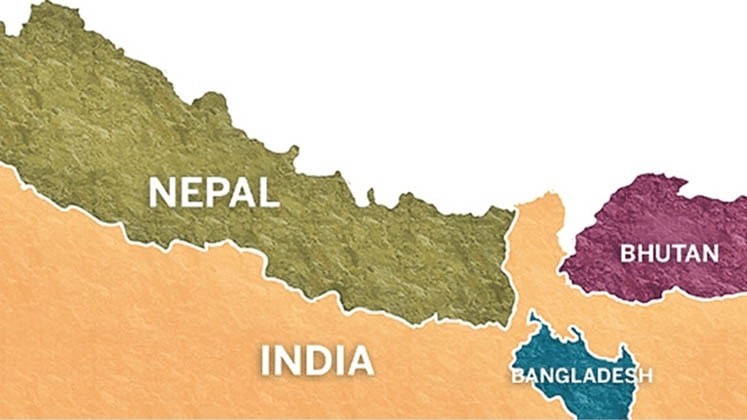
Improved connectivity between Bangladesh and India, alongside Bhutan and Nepal, has the potential to make the sub-region an economic growth pole for South Asia.
World Bank India Head Junaid Ahmad, recently appointed as Vice President of Multilateral Investment Guarantee Agency (the international lending agency), underlined this while dwelling on the subject of Bangladesh, Bhutan, India and Nepal (BBIN) initiative.
As conceived, BBIN is a regional transport initiative where a motor-vehicle agreement was signed — The BBIN Motor Vehicles Agreement (MVA) was signed on 15 June 2015 at the BBIN Transport Ministers meeting in Thimpu — for developing a sub-regional protocol for cost-effective, efficient and seamless multimodal transport system linking the four South Asian nations.
Significance for Bangladesh
BBIN carries immense significance for Bangladesh in fostering value chains, especially in context to its apparel sector for which imports from India play a major role as far as raw material supply is concerned, not to mention the strong emergence of India as an apparel export destination, where exports have already crossed the US $ 1 billion mark.
“With the exception of 25 specific products, including alcohol, India has allowed all Bangladeshi exports duty-free access since 2011 in a bid to help reduce the trade gap,” observed Indian High Commissioner in Bangladesh Vikram Doraiswami, adding annual trade between Bangladesh and India has the potential to reach US $ 16 billion if the former improves its ease of doing business and completes all connectivity developments.
Then there is Bhutan, with which Bangladesh signed its first ever PTA some time back, opening the gates to enhance exports to the Himalayan kingdom as well.
Bangladesh struck its maiden preferential trade agreement (PTA) with Bhutan on 6th December 2020 even if the agreement allows duty-free export of 100 goods including apparels, consisting of export-oriented items like baby clothes and clothing accessories, men’s trousers and shorts, jackets and blazers, apart from jute and jute goods, leather and leather products, etc.
As an export destination, Bhutan may not be very significant for Bangladesh garment makers considering its market size. However, the same cannot be maintained about India, where shipment of ‘Made in Bangladesh’ apparels is rising by the day riding on the zero-duty trade benefit and competitive prices.
Thanks to the upwardly mobile middle-class in the world’s second-most populous nation, Bangladesh exporters say demand for apparels is skyrocketing, leading global brands and retailers operating in the country (India) to look up to Bangladesh to meet their sourcing requirements.
Then there are the local retail outlets and brands that have sprung up to cater to the burgeoning quality and price-sensitive consumer base, which led them again to go knocking at the doors of Bangladesh suppliers; after all there’s not many who can offer quality and price-competitiveness at the same time as do the apparel makers from Bangladesh.
Some Indian garment exporters re-export Bangladeshi garment items to other countries as well, which is another reason for rising shipments to India, claimed some in the industry including Md. Shahidullah Azim, Managing Director of Classic Fashions Ltd.
“This is another major reason for increasing garment exports…,” said Md. Shahidullah claiming his company sends nearly US $ 3 million worth of apparels to a Dubai-based company through Indian exporters even if the Indian envoy in Dhaka suggested how ensuring cheaper transportation along with quality products can enhance Bangladesh’s competitive edge in the Indian market.
BBIN fails to give the desired thrust!
Despite high expectations from the BBIN initiative in this regard, six years into signing of the deal, it has failed to live up to the expectations.
Although three countries ratified the agreement, Bhutan back-tracked citing environmental concerns following which, BBIN move slowed and has been struggling ever since!
Integrating roadways, inland waterways, the railway and coastal shipping transport systems is very important in reaching the true potential of the deal which would consequently help boost exports, say industry insiders while adding it is of paramount importance that all stakeholders reach a consensus regarding the implementation of the BBIN deal and establish a multimodal connectivity protocol.
Bilateral trade between Bangladesh and India represents only 10 per cent of the former’s foreign trade and 1 per cent of India’s, as per a report, which underlined a key factor for the low trade volume is sub-optimal transport integration in the region while adding BBIN is a cornerstone of that integration, and if implemented in full, it could lead to seamless movement of passenger, personnel and cargo vehicles across the South Asian countries.
Improving transport connectivity could increase exports further, yielding a 297 per cent increase in Bangladesh’s exports to India, while seamless transport connectivity between the two nations could increase national income by as much as 17 per cent for Bangladesh, observed Second Secretary (Commercial) to the Indian High Commission Pramyesh Basall.
“The BBIN deal and a multimodal BBIN connectivity protocol could have a significantly positive impact on the economy… Implementing the BBIN deal could help Bangladesh reverse the pandemic-induced economic slowdown,” added further former Governor of Bangladesh Bank Dr. Atiur Rahman.
Atiur Rahman is also of the opinion that it’s not only connectivity infrastructure, capacity of Bangladesh’s ports and commercial hubs also need to be significantly increased to reach the full potential of trade between BBIN countries.
“The most important trade route between Dhaka, Chittagong or Mongla and Thimphu goes through Burimari and eventually goes over the Jamuna Bridge before being connected to Dhaka,” underlined a recent report adding, “This route is a part of (the) BBIN (deal) and can also be used as a multimodal route by starting from Thimphu-Jogighopa and Jogighopa-Chilmari-Dhaka while in the same manner, another route can be made multimodal as the rest of India can be connected to Kolkata via rail or roadways and then head onwards to Chittagong via waterways and then in the final leg, from Chittagong to Tripura via roadways.”
BBIN gains for India
The significance of BBIN is no less for India either.
As India and its neighbours focus on speeding up economic recovery in the post pandemic phase, timely implementation of the BBIN Motor Vehicles Agreement would be critical, say experts in India even as a World Bank analysis found under the MVA, a truck travelling from Agartala in India’s north east to Kolkata port will take 65 per cent less time while also being 68 per cent cheaper.
North-eastern India and the neighbouring countries of Bangladesh, Bhutan and Nepal have natural complementarities which could be exploited to create robust, mutually beneficial economic relationships, they said, adding effective implementation of the BBIN Motor Vehicle Agreement will lend the much-needed impetus to the collaborative efforts to harness economic complementarities and create value chains transcending borders.
Export to Bangladesh using IWT has already gone up in recent years even if Dhubri (in Assam) is now well connected with Narayanganj (in Bangladesh) through IWT and there has been regular sailing of cargo vessels while neighbouring Bhutan has been using this IWT route for trade with Bangladesh.
Further, developing the railway link to Sabroom in Tripura and linking it with Chittagong Port will open new vistas, say experts and, India, it seems, is taking the issue of connectivity rather seriously.
The Land Ports Authority of India (LPAI), which is the nodal body under the aegis of the Ministry of Home Affairs and responsible for maintaining and managing border infrastructure, is reportedly looking at developing rail connectivity with three integrated check posts (ICPs) along the Indian border, namely Raxaul, Petrapole and Jogbani.
No ICP is connected by railways currently.
As per reports, the ICPs at Petrapole-Benapole near Kolkata and the Agartala-Akhaura (Bangladesh) are the two main points of trading points between India and Bangladesh even if trade worth more than Rs. 4-6 crore takes place every day at each of the ICPs.
“Multimodal transport system through road, rail and even waterways network at ICPs are important to ensure last-mile connectivity of cargo to boost trade,” claimed Executive Director of CUTS International Bipul Chatterjee.
Consumer Unity & Trust Society or CUTS is a non-profit organisation that focuses on providing the poor with access to developmental opportunities.
The LPAI is also, reportedly, looking at the prospect of linking a few selected ICPs with nearby waterways including Mongla and Chittagong ports, which Bangladesh has allowed for India to use as transit for cargo movement to north-east that would cut down distance between Kolkata and Agartala via Assam from 1,600 km to just about 450 km.
WB intervention set to change things…
Now with the World Bank pledging US $ 750 million on salvaging the struggling BBIN corridor, it has come as a timely and requisite push towards furthering the goals of regional connectivity, said people in know of things,who added the Washington-based lender has offered to assist in major concern areas including improving port efficiency, customs modernisation, trade facilitation and upgrading regional-connectivity infrastructures.
“The proposed US $750-million loan will be provided to Bangladesh for upgrading the trade and regional connectivity,” said a senior Economic Relations Division (ERD) official, adding, “…they have assured us of providing the funds to facilitate regional connectivity.”
That Bangladesh wants to enhance its capacity and infrastructure for facilitating the trans-border traffic initiative,only add to the efforts.
As per reports, under the project, the World Bank has offered Bangladesh Land Port Authority US $250 million for upgrading Benapole, Burimari and Bhomra land ports for enhancing their foreign trade-handling capacity even if the Washington-based lender is expected to also make available US$170 million for upgrading customs houses in seaports and land ports while also conducting reforms and modernising Bangladesh’s tariff and trade policies.
There’s also the US $300 million loan for upgrading a highway that would improve the cross-border trade and business as part of which the Roads and Highways Department (RHD) will upgrade the Sylhet-Charkhai-Sheola-Sutarkandi highway, which in turn would connect the Asian Highway-1 and 2, even if the highways in question here will be a part of the Bangladesh-China-India-Myanmar (BICM) road corridor.
Bangladesh will also get US $16 million worth of funds to enhance and carry out reforms in trade policy, tariff policy and, National Trade and Transport Facilitation Action Plan from the World Bank even as the multilateral development financier underlined seamless connectivity between Bangladesh and India would increase the former’s real income by 17 per cent.
Given the role and importance of BBIN towards furthering the goals of regional connectivity to make the sub-region what experts call ‘economic growth pole for South Asia’ while also giving that much-needed traction towards bolstering India-Bangladesh trade, the World Bank efforts would go miles, say people in know of things, winding up on a positive note.






